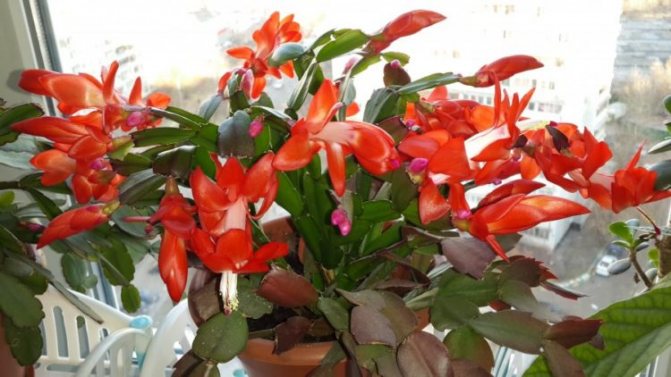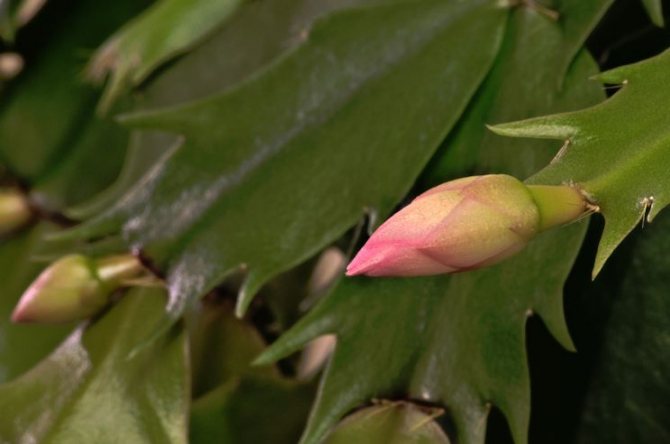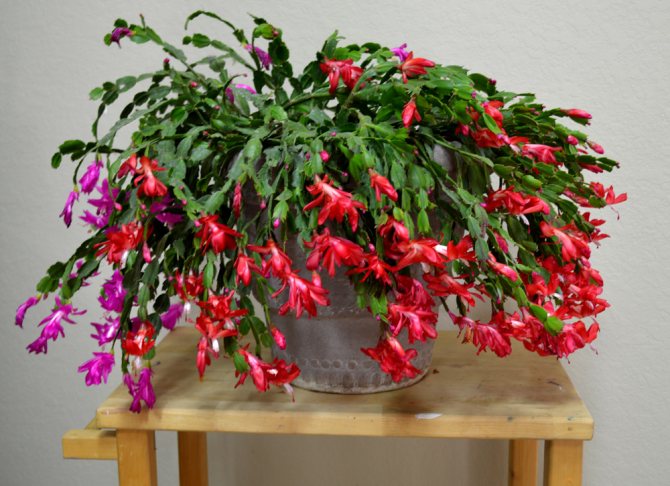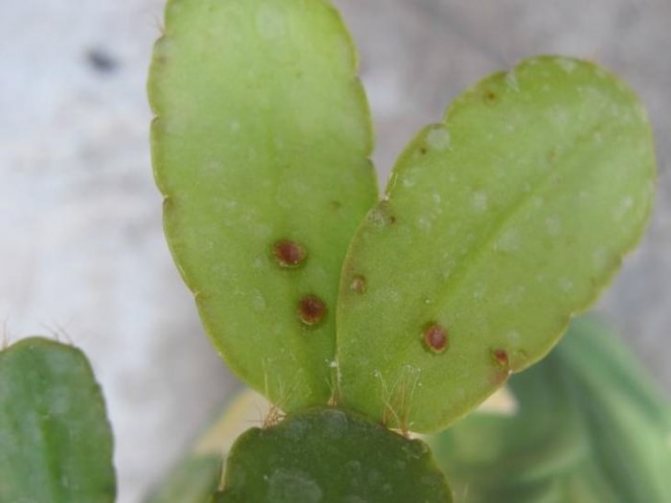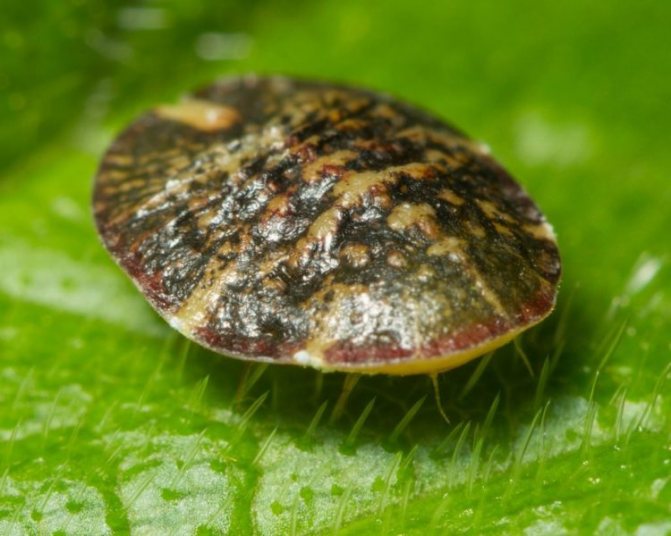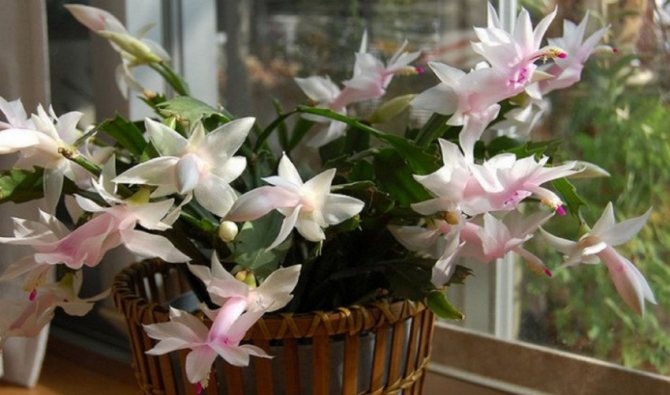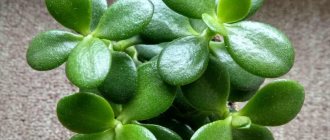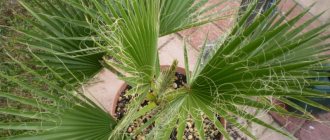Schlumberger got its second name due to the abundant flowering in December. How beautiful a flowering plant looks on the windowsill when there is snow and blizzards outside the window.
If you provide the plant with proper care, then it can delight you with beautiful flowers every year. The flower is quite unpretentious to care for, so it can be found in many gardeners.
But, despite its undemanding content, the Decembrist can be attacked by pests and various diseases. In this article, we'll take a closer look at the main causes of leaf redness in this gorgeous flower.
Diseases and their photos and treatment
Schlumberger fungal infections
Phytophthora and Pithium
These two diseases are transmitted with contaminated soil and damage the original root collar. The very first symptom of the disease is the massive fall of the segments, withering of a flower with high soil moisture (about why the Decembrist has sluggish soft leaves and how to fix the situation, read here). After that, the plant takes on a gray or pale color. For treatment, use the following drugs:
- Speed For 1 liter of water, 1 ml of the drug. The solution consumption is 0.5 l per plant.
- Topaz. To spray the plant, take 2 ml of the drug per 10 liters of water. Carry out processing at the first signs of illness.
- Maxim. Dilute 5 drops of the drug in 200 ml of water. Use a spray agent.
- Vitaros. Dilute 2 ml of the drug in 2 liters of water. Spray 2 times at intervals of 10 days.
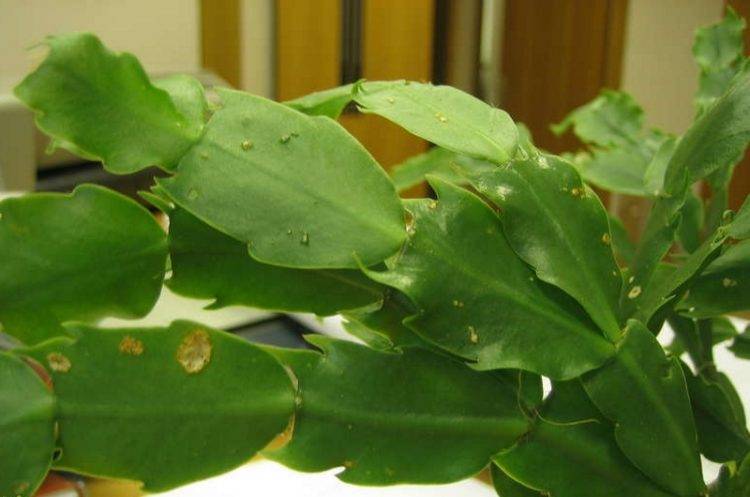
Fusarium
This is a fungal disease of zygocactus, the development of which is influenced by a fungus of the genus Fusarium. It penetrates into the plant through the soil and wounds, leading to decay of the root system and neck. For prevention, drugs such as Mikol and Bayleton are used. If an infection with fusarium has occurred, then it is no longer possible to cure it. When the lesion has become obvious and the vascular system is damaged, then remove the diseased specimen and burn it, and the soil in which it grew should be treated with a weak solution of potassium permanganate.


Bacterial lesion
The most common bacterial infection remains that which occurs against the background of the Erwinia bacteria groups. The symptoms are as follows: first, a wet, sliding dark spot forms at the base of the stem, and if no action is taken, it will begin to cover the entire stem.
If only part of the stem is affected, then it is easier to break off the cutting higher along the stem. and notice a diseased plant, growing a new one from the petiole.
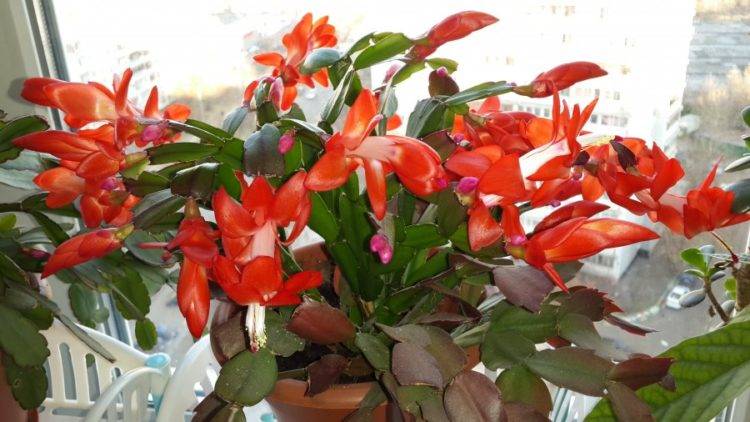

Flower pests and fight against them
Spider mite
This parasite can cause significant damage to the plant. If you look closely, you can see the spider mite with the naked eye. Insects are small in size, can be yellow, brown and red. The main reason for the development of spider mites is dry air. If this pest dwells on the Decembrist, then it is worth treating the plant with the following drugs:
- Fitoverm.
- Neoron.
- Aktellikom.
It is necessary to observe the intervals between treatments, which depend on the air temperature in the room:
- +20 degrees - 9-10 days;
- +30 degrees - 3-4 days.
We save the Decembrist:
- At the first symptoms of damage, you need to thoroughly wash the flower with laundry soap, then re-soap and leave in the same form for 2 hours.
- After the solution has been removed with water, put a plastic bag on the plant and leave for 7-10 days.
- Such manipulations should be carried out after another 7 days, since the laid eggs of the spider mite may remain after the first procedure.
After processing, it is necessary to increase the humidity of the air by spraying or placing the flower in a pallet with wet pebbles.
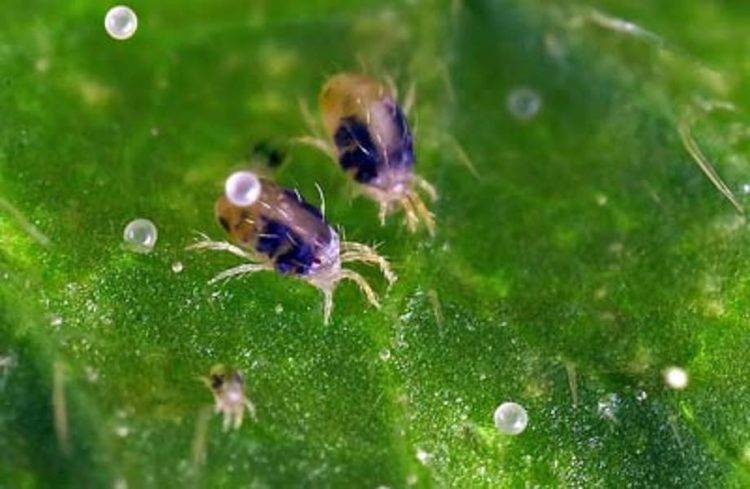

Mealybug
It is a sucking insect with an oval pink body covered with a white coating. There are transverse stripes on its back. The parasite is 3-7 mm long. Mealybugs can be detected by the presence of white sticky mucus on the leaves of the flower. The buds of the plant are affected by the insect, wither and fall off.
For prevention, it is necessary to regularly water and remove dried leaves. If the infection has occurred, then the bush will have to be treated with Aktara or Confidor insecticide. 200 ml of water accounts for 2 ml of the drug. Spray the plant with the resulting solution, and repeat the procedure after 7 days.
From folk remedies, the following recipes remain effective:
- Mash 25 g of garlic, add 1 liter of boiling water. Insist for 6 hours, and then wipe the plant with a brush dipped in the infusion. You need to hold such events in the evening. Cover the flower from sunlight for 2 days.
- Mix 1 liter of water and 40 ml of olive oil. Soak a cotton pad in the solution and go over all the elements of the plant.
- Grind 10-15 g of green soap on a grater, add to 1 liter of water. Spraying is to be carried out 3 times, observing intervals of 7 days.
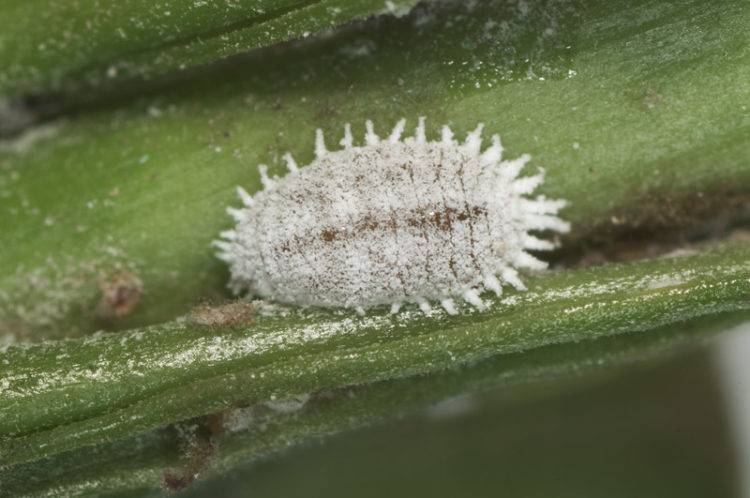

Shield
The dimensions of this parasite do not exceed 5 mm. The shield sucks out all the juices from the Decembrist. After that, his leaves turn yellow and dry out. If you do not start treatment in a timely manner, the flower may die.
To combat the parasite, you must use mechanical cleaning. Its essence is to apply a solution of Karbofos or Tanker on a cotton pad. Run a cotton swab over the affected areas of the plants. Ankara solution can be used for treatment (8 g of the drug per 10 l of water). In addition, it is necessary to revise the humidity in the room so that it does not fall below 60%. Also, bright sunlight slows down their development.
From folk remedies, you can try the following:
- Combine 1 liter of water and 40 g of laundry soap. Add 5 drops of kerosene to the solution and shake thoroughly. Wipe the problem areas of the Decembrist with the composition.
- Take a medium-sized onion, chop finely and add 200 ml of water. Insist for 2-3 hours, filter and moisten a cotton pad in the solution, walk through problem areas.
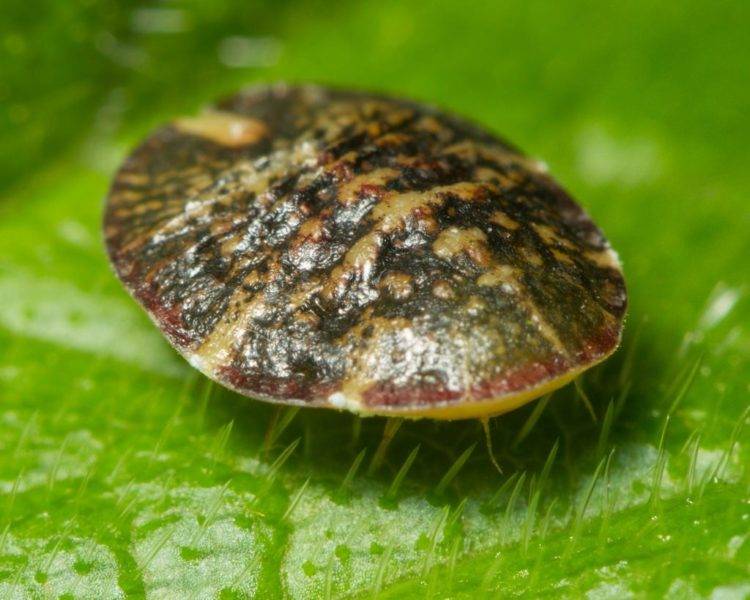

We offer you to watch a video about the pests of the Decembrist and how to deal with them:
Christmas pests and the fight against them
The Decembrist, with proper care, can live for several decades. But over this long period, it can be attacked more than once by pests, the main of which are spider mites, mealybugs, and scale insects.
Spider mite
If a rust-colored plaque and cobweb appear on the Decembrist, then this is the first sign of the occupation of the plant by a spider mite. This insect can thoroughly harm the zygocactus, if it is not detected in time and measures are not taken.
A close examination will help identify spider mites - a small pest with a yellowish, brownish or scarlet hue. These pests are attracted by the dry air in the environment. To get rid of a spider mite, you should:
- at the first symptoms, the plant should be washed with a solution of laundry soap, rinsed, repeated the procedure, leaving it in soapy water for a couple of hours, rinsed again, put a plastic bag on the plant and leave it in this position for a week and a half.After a week, you need to repeat the course of treatment with a solution of laundry soap again, since after the first stage there may still be spider mite eggs;
- to treat the plant with Fitoverm, Neoron, Aktellik, after three to four days, process it again;
- after the procedures carried out, you need to humidify the air by spraying or put the plant in a container with moistened pebbles.
Did you know? There are zygocactuses, the stem diameter of which is more than a meter, and they themselves are decorated with thousands of flowers.
Mealybug
When whitish lumps similar to cotton wool appear on the Decembrist, it becomes clear that the plant is occupied by a mealybug. This pest has a pink color with transverse stripes and is a sucking insect. The size of the mealybug - from 3 to 7 mm - allows you to notice it quickly enough.
His presence is indicated by:
- whitish sticky mucus on the leaves;
- wilting and dropping of buds.
Getting rid of mealybugs is a rather lengthy and difficult process. It consists in:
- spraying the plant with Aktara or Confidor insecticide;
- processing with a solution obtained according to one of the folk recipes: dilute 25 g of mashed garlic in 1 liter of boiled water, leave for 6 hours, wipe all parts of the plant with the resulting mixture; Stir 40 ml of olive oil in 1 liter of water and treat the whole plant with a cotton swab dipped in a solution; grate from 10 to 15 g of green soap and dilute in 1 liter of water, spray the Christmas tree.
All procedures should be carried out at least three times with an interval of a week.
Did you know? Used in botany, the name of the zygocactus Schlumbergera was obtained in honor of the French cactus collector Frederic Schlumberger.
Shield
An insect, the size of which is not more than half a centimeter, and it itself is capable of sucking all the juices from a Christmas tree, is called a scabbard. From its harmful effects, the Decembrist turns yellow and dries. With untimely assistance, the plant may die. The following methods can fight the pest:
- mechanical cleaning;
- processing with a cotton swab dipped in a solution of karbofos, "Tanker" or "Ankara";
- ensure the air humidity in the room is at least 60%;
- place the plant for a while under the rays of the sun, as they slow down the development of the lesion;
- processing the plant with folk remedies: dilute 40 g of laundry soap in 1 liter of water, adding five drops of kerosene; finely chop a medium-sized onion and pour a glass of water, leave to infuse for a couple of hours, strain.
Did you know? Zygocactus are able to absorb unnecessary noise in the house and any other room.
How to reanimate and save a badly damaged and dying plant?
The Decembrist can die for various reasons: too low temperature, abundant watering, lack of light, insufficient feeding. It is possible to save the damaged plant by the method of re-rooting. The essence of this procedure is as follows:
- Pinch off 3-4 leaves, place them in water and roots should appear in 12-14 days.
- Purchase soil for cacti (Garden of Miracles), pour it into a container with drainage holes.
- Transplant the flower into a pot, pour with warm water.
- Transplant the old flower into fresh soil and water less. After transplanting, do not feed for a month.
Decembrist is a very beautiful plant that is successfully grown at home. Of course, like any indoor flower, it can hurt. The main task of the grower is to comply with all the conditions for growing Schlumberger, to prevent waterlogging, over-saturation with nutrients and to cure all diseases in a timely manner.
dacha.expert
All plants have their own characteristics. The main feature of the Decembrist is that it blooms when other flowers are resting.But he also has other qualities that distinguish him from all the other inhabitants of your windowsill. Firstly, the Decembrist is uncomfortable on the southern and western windowsills, since intense lighting can cause the end segments of the plant shoots to die off. secondly, in the summer, the Decembrist, like no other houseplant, needs fresh air: a shaded place on the balcony, loggia, terrace is suitable. Thirdly, in the summer, the Decembrist likes to take a shower, but if this is not possible, then at least spray it from time to time. Fourthly, with good care, a long-liver Decembrist can congratulate you with his bouquet on the New Year for 15-20 years. Fifth, the Decembrist flower belongs to those capricious plants that cannot be disturbed at the moment of budding - rearranged from place to place and even turn the pot with the plant. Sixth, the Decembrist can be grown like an ordinary plant, or it can be grown as an ampelous plant. Caring for a Decembrist at home How to look after a Decembrist. The agrotechnics of the Decembrist zygocactus is directly opposite to the agrotechnics of cacti themselves, their requirements for the most part coincide with the conditions for growing ordinary, deciduous indoor plants. If you can forget to water a cactus, and it will not suffer much from this, then the Decembrist needs regular watering with settled cold water and high humidity, which is achieved by regular spraying or placing a pot with a Decembrist on a pallet with wet pebbles. Cacti perfectly tolerate the sun, and the Decembrist suffers from direct sunlight and requires shading. As for the air temperature, the Decembrist is not capricious in this matter. Since March, the Decembrist needs monthly feeding with complex fertilizer for flowers, but the dose should be taken half as much as suggested by the manufacturers. In the summer, when the intensive growth of the stems begins, you need to feed the plant twice a month, and stop feeding from September. Preventive treatment with fungicides will not interfere with the plant.
Fertilizers to stimulate flowering
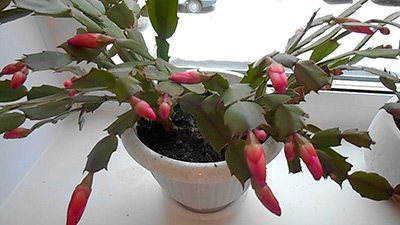

If some flowers fall off during flowering, then perhaps the plant does not have enough phosphorus and potassium. Therefore, start feeding the plant in April.
And a month before the Decembrist blooms, stop fertilizing. In the summer, the plant starts up its forces on the growth of leaves, so apply fertilizers more often - twice a month. Purchase fertilizer for flowering plants and cacti as top dressing. You can also use a highly diluted mullein.
Ash is great. When transplanting a flower, ash is mixed with earth. Or you can water the flower by diluting 2 tbsp. tablespoons of ash 1 liter of water.
You can use sugar by diluting 1 tbsp. spoon in half a liter of water and watering the plant with it.
Cut the peels of tangerines, oranges, lemons, pour 3 parts of boiling water into 1 part of the peel. Leave to infuse for a day. Then strain the composition and water, diluting every half liter of the resulting infusion with half a liter of water.
Yeast contains a huge amount of nutrients. Therefore, dissolve 2 tbsp. spoons of yeast and 1 tbsp. a spoonful of granulated sugar in 1 liter of warm water. Leave it on for 2 hours. Then dilute the yeast infusion with water, pouring 5 parts of water to 1 part of the infusion.
What are the causes of reddening of the leaves of the Decembrist
To understand why the Decembrist's leaves turn red, you need to navigate in the conditions of its maintenance. Several factors can cause discoloration.
Too much bright light
Under natural conditions, the Decembrist grows like an epiphyte in the shade of trees, so he does not like bright light. For its cultivation at home, eastern or western windows are suitable, in especially hot weather it can be rearranged to the north side. If the plant is located in the southern part of the room, then it must be shaded. Otherwise, spots of red or purple color will begin to appear on its leaves. In addition, the flower may receive a sunburn or the extreme segments will begin to fall off.
Growth of new segments on leaves
At the beginning of spring, new segments begin to grow on the leaves of the plant, so the tips of the shoots acquire a red color. In this case, do not worry, as they grow, they will turn to their usual green color.
Incorrect feeding
For the good development of the Decembrist, proper feeding is of great importance. It starts in the middle of autumn and stops after flowering. To do this, you can use cactus fertilizers. They contain a sufficient amount of nitrogen, potassium, phosphorus, magnesium and other elements that are necessary for the Decembrist.
Leaf redness can develop from a lack of nutrients, especially phosphorus. During the period of active growth of shoots, you can alternate mineral fertilizers with organic matter.
Excessive watering
The Decembrist does not like strong waterlogging of the soil. Watering should be regular, but not strong, between them the topsoil should dry out. Frequent overflows lead to the fact that the root system begins to rot, and the foliage wither and acquire a red color. To prevent the plant from dying, you need to let it dry well, and then adjust the watering regime. If possible, it is recommended to transplant the plant into new soil, after rinsing the root system and removing the decayed parts.
Step by step instructions: what to do if zygocactus leaves turn red?
First of all, as mentioned above, the plant needs proper care. This is usually enough for the leaves to return to their original green color.
If the cause of the reddening of the leaves was waterlogging, then most likely the roots of the flower were struck by rot. How to save a plant?
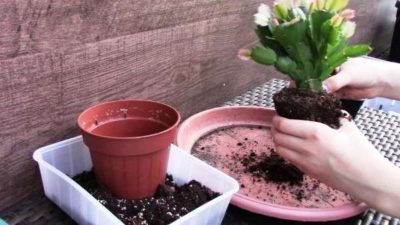

Algorithm of actions:
- inspect the flower well for pests, if any, then the ground part of the plant must be treated with special preparations;
- prepare new soil, antiseptic composition and sharp scissors, it is better if it is a small garden pruner;
- remove the plant from the pot, gently free the roots from the ground;
- rinse the root system under a stream of warm, running water;
- inspect for decay;
- remove all damaged fragments with a sterile instrument, grabbing 1-3 cm of healthy tissue;
- treat all sections with an antiseptic - it can be crushed activated carbon, ash or simple brilliant green;
- leave the plant to air dry for 2-4 hours;
- lay a drainage layer on the bottom of the pot - perlite, fine gravel;
- close the drainage with soil;
- dip the roots into the pots and sprinkle with earth.
Attention! The roots of the Decembrist are very delicate, so it is better not to press the earth, but to compact it with a little shaking.
Immediately after transplanting, the plant is not watered, leaving it alone in a shaded place for 2-3 days.
Florist tips and tricks for proper care
Many growers believe that the cause of wilting and reddening of the Decembrist leaves can be:
- Hypothermia of both the ground part of the plant and its root system. It can occur when the room is ventilated during the cold season or when there are drafts. In this case, experts recommend cutting off the damaged parts of the shoots, and then watering and spraying the plant with Zircon solution in accordance with the instructions.
- Frequent overdrying of the soil, which leads to the depletion of the root system and shoots. In this case, you need to reconsider the number of waterings.
As can be seen from the above, there are not very many reasons leading to the reddening of the Decembrist foliage. This problem can be avoided by knowing what to do in the event of a given situation.In return for caring, the plant will respond with good growth of a lush crown of bright color, as well as colorful and long-term flowering, which will be an excellent decoration for any room in winter.
A little about Schlumberger
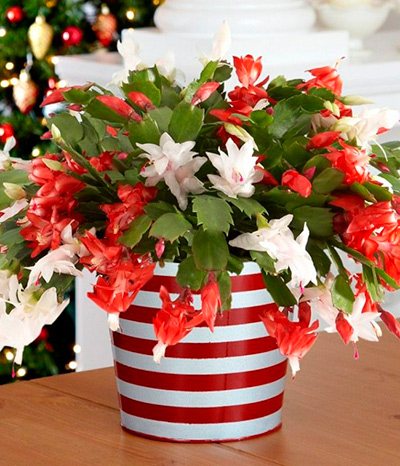

The plant was brought to Europe by Cunningham in 1816. The plant that Cunningham tended bloomed with scarlet flowers.
But then the breeders bred the species of the Decembrist, having snow-white, pale pink, purple, bright orange flowers. Now you can even buy a plant with flowers of several colors.
The Decembrist has many more names: zygocactus, epiphytic cactus, Christmas tree. A Christmas tree can live 15-20 years if properly cared for.
When vaccinated, a standard form of a Decembrist is obtained, which blooms very profusely. For this, they purchase the Peiresquia cactus. The upper part of the cactus is cut with a sharp knife, then the stem is slightly split and then a cutting of 2-3 segments of the Decembrist stem is placed in the split.
At the end, they are fixed and wrapped with a thread of wool. When the slices grow together, the foliage is cut off from the cactus, and the thread is removed. When a Christmas tree grows a crown, it is tied to a peg, then it will not break off.
> How often does it bloom?
Schlumberger blooms once a year in December or January, this is due to the fact that the plant belongs to epiphytic cacti, hence a similar flowering period.
Description of the flower Decembrist
Content of Zygocactus
As you already understood, the scientific name of the Decembrist flower looks like Schlumbergera. It is sometimes referred to as Zygocactus. Everyone is wondering if it is possible to keep a Decembrist flower at home. Practice shows that this is possible. We are dealing with a completely non-capricious plant. Place it on a well-lit, but not sun-drenched windowsill. It should be cool in the habitat of the Schlumberger Flower. The presence of heating devices that give intense heat to it is not encouraged. From spring to the end of autumn, the plant will feel good on the veranda or balcony, you can also keep it right outside if you live in a private house and have a patio.
Varieties of the Decembrist flower
There are different varieties of Decembrists. Mostly indoor plant lovers are interested in the two most popular species, and we will focus on them.
Schlumberger Buckley
The old variety of Zygocactus is the classical Decembrist or Schlumbergera bucklei. In this plant, the stems consist of elongated fragments of a characteristic shape with a rounded relief. Drooping shoots are characteristic of ampelous plants; they are pronounced in the Bouclei variety. The tips of the segmented shoots are decorated with mauve flowers. Beautiful flowers are made up of delicate petals in several rows. The stamens are quite noticeable and long.
Truncated Schlumberger
The second common flower variety, Schlumbergera truncatus, looks a little different. Each segment is framed with scalloped patterns. The tube of the flower is long and uneven, the exact opposite of the symmetrical, even flowers that Zygocactus Bouclei gives. Due to the works of experts, many color variations of the Truncated Decembrist were derived. For example, colorful, white, lavender, golden, salmon, pink, orange, and raspberry.
The benefits and harms of the Decembrist
The properties of the Decembrist flower are mostly positive. It is believed that the energy of this plant heals people. Speaking about the usefulness of Zygocactus, we do not mean omens and superstitions, but we are talking about a real healing effect. So, experts recommend keeping the Decembrists in a home where negative energy reigns. There is a high-quality filtration of the negative with the help of this plant.
It's great if you place the Decembrist near the bed. From it you will be perfectly recharged while you sleep.Many people ask whether the Decembrist flower is a vampire or a donor. Obviously, he is an emotional donor. A person drains all negative waves to the plant and begins to feel much better. It is believed that lovers of the Schlumberger flower are less prone to pathology of the musculoskeletal system, muscle problems.
Some believe that Zygocactus can scan the future and respond to hidden negative factors. Here lies the answer to the question of why the Decembrist is fading. For example, in the absence of flowering for no apparent reason, trouble can be expected. When a plant, under normal conditions, suddenly drops buds and leaves, then in the near future someone from home will suffer. Also, after the arrival of guests with bad intentions, the Decembrist may suddenly wither, throw off foliage and flowers.
The flower does not have any harmful effect, which is why it is so popular in residential, children's, educational, and medical institutions.
Decembrist propagates by cuttings
Frequent mistakes
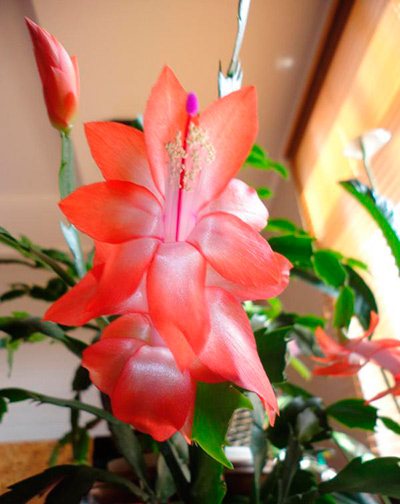

The most common mistake when the owner of a flower thinks that since the plant belongs to the Cactaceae family and does not require careful care, then it is not necessary to follow the Decembrist at all.
Also, plant owners often believe that the segments of the stem are falling off, and the plants are dropping their buds from insufficient watering, but this is not true, since in such a situation the Christmas tree will most likely simply wither.
Don't leave the Christmas tree in a draft. Otherwise, the flower will overcool, the roots will rot and the plant will wither.
If you water the flower too abundantly, the foliage will begin to fall off.
Very often people mistakenly believe that if you put a Decembrist in a roomy pot, then it will grow more actively. But in its natural environment, this plant has small roots, as it attaches to trees. Therefore, Schlumberger is planted in a pot as small as possible.
A pot is selected that is 3 times less in height than the length of the stem. Then the zygocactus will spend its energy on the growth of the stem and the formation of buds. If you plant it in a very deep pot, then it will grow roots, they will begin to come to the surface, and Schlumberger herself will not bloom.
A plant may drop buds if there are too many of them, since the plant no longer has enough strength to bloom. Therefore, if there are more than 4-5 buds on each pagon, then cut off the extra ones.
How to properly care for a Decembrist flower?
Good soil for a flower
Natural Schlumbergers are epiphytes and can be found in the crevices of tree bark. Based on this condition, we conclude that the home soil must have a number of requirements. It is enough to be breathable, loose and moisture permeable.
Here is a generally accepted recipe for preparing soil in which Zygocactus exist well:
- coarse sand - 1 part;
- sheet land - 1 part;
- additive - peat and charcoal.
In soil with such a balanced composition, Zygocactus will eat well, feel good and look great.
Decembrist transplant at home
Florists should know in all the details about how the Decembrist flower is transplanted. It is believed that the transplant should be done once every 1-2 years. It is advisable to pause after flowering is complete. The optimal period is the activation of growth, the so-called vegetative period. This time begins in mid-March and lasts for more than one month.
To successfully transplant a Schlumberger flower, choose a pot 2 centimeters freer than the old diameter. It is permissible to use a low pot due to the superficial location of the root system; it does not penetrate deep into the soil.
It is imperative to arrange drainage holes. This is a prerequisite for the plant to exist as in nature and not experience discomfort. It is equally important to make a drainage substrate, its normal thickness is 2-3 centimeters.What is it made of:
- pieces of broken brick;
- expanded clay;
- Styrofoam.
Reproduction of the Decembrist
Experienced growers recommend propagation by cuttings for the Schlumberger flower. The bush can be cultivated by removing the shoots from the top, where there are 1 or more shoots. A good time for breeding is the spring-autumn season. Carefully turn the stalk away from the main bush, hold it for up to one day, during which time it will dry out a little. Next, we plant the material, deepening it by about a quarter of the length. The soil should be moist and loose. With this approach, successful and fast rooting of cuttings is guaranteed, without effort on your part.
Decembrist care all year round
Vegetative period (March-September)
This period of time is distinguished by the intensive growth of Zygocactus. The plant grows larger, fresh shoots grow. Install for these months the Decembrist on the windowsill, where air circulates actively. You can take it out into the yard or on the balcony. Nevertheless, it should be noted that an ideal environment for a flower is a place in the fresh air in the light partial shade of other plants.
Remember to spray the flower frequently using warm water during the summer months. The significant question is how to water the Decembrist flower. In this matter, it is important to observe the measure. If necessary, water as soon as the earthy clod dries up. Try never to flood your Decembrist, since putrefactive processes develop rather quickly against the background of excess moisture.
Summer care also includes generous plant nutrition. Universal and nitrogenous mixtures - this is what you need to fertilize the Decembrist flower once every 2 weeks. It is advisable to maintain the temperature in the room where the Schlumberger flower grows in summer, between 20 and 23 ° C.
Rest time before flowering (October)
This month is intended for the accumulation of strength to release flowers soon. The formation of buds for flowering is already in progress. October is a decisive time for intensive care as it determines the potential for flowering or lack thereof. The dormant period differs in that the Zygocactus needs less time to stay in the light and give a smaller amount of moisture. But fresh air and coolness will need to be increased. The temperature regime for autumn is 10-18 ° C.
During the summer months, the Decembrist lived on the street or balcony. If frost has not come, then you can not remove the flower in the heat until November. A little cooling is beneficial and creates conditions for the buds from which flowers will soon grow. The plant survives short-term cold up to 3-5 ° C well. Water the Schlumberger flower less frequently in October. The fact that water is still needed can be judged when the sprouts wither and become soft.
Try watering the plant with tea instead of water. This will help increase the number of buds for flowers, as the tea acts as a fertilizer and heals problematic Decembrists. When November is approaching, feed by using fertilizer for flowering plants. Such a measure will help enhance flowering.
Flowering time (November-January)
The last days of October and the first days of November - during this period, it is necessary to rearrange the plant in a warm place, begin active watering of the flower. The best liquid option is warm tea. During the flowering period, fertilizers based on phosphorus and potassium are needed. In order for the Decembrist to be able to create strong buds, you need to additionally water it with an infusion on the eggshell (insist ground shells from washed raw eggs for a day) or a solution made from calcium nitrate.
After a week, you will be able to see the first buds. The Schlumberger flower blooms best at a temperature of:
- from 15 to 20 ° C - for the night;
- from 19 to 22 ° C - for the day.
While the plant is covered with buds, do not turn the pot around in relation to the lighting. Do not bother him, do not change the place, and do not wash.
Rest time (February and March)
When the flowering period is over, it is necessary to issue the Decembrist. To do this, unscrew and remove the sprouts located on top of the shoots. This technique is designed to make your bush more branched and thicker. Do not forget about watering during the rest period, waiting for a moderate, but not strong drying out of the earth clod.
Decembrist blooms from November to January
Christmas cactus (decembrist) video
I don’t know why you didn’t respond to my comment, but I asked not out of idle curiosity, but out of a desire to help. In order to find the cause of the disease, to help the plant, you need to know its scientific name and the conditions under which it grew before the disease. A photo of a plant will be a good help in making a "diagnosis". You personally come to the doctor's appointment and tell in detail about what hurts, and do not tell him on the phone: “My stomach hurts. What to do?".
The "Decembrist" is most often called the epiphytic cactus to Schlumberger, although this plant can be confused with a variety of hatiora and ripsalidopsis. Although the care of one or another type of epiphytic cacti is generally similar, you need to know the exact name. The entire terrestrial part of Schlumberger is articulated shoots, leaves are missing.
Schlumberger's "leaf fall" can be caused by excessive dampness, especially in combination with a lack of light, transplanting into a pot for growth, periodic overdrying of the soil, followed by abundant watering. At the moment it is not clear what is the composition of the soil, the frequency of watering, the level of lighting?
I'll tell you briefly about caring for a Schlumberger. The soil should be loose with the addition of a small amount of sand, pieces of charcoal, perlite (approximate composition), the pot when transplanting is slightly larger than the root ball by a couple of centimeters.
Water this cactus when the top layer of the soil dries up by about 1-2 cm, provided there is good lighting. During the period of active growth, especially in summer, stagnation of water at the roots (you cannot leave water in the pan for a long time), overdrying of the soil. Watering is done so that all the roots get water.
During the dormant period for laying the buds, the frequency of watering is reduced until the soil dries out almost to the very bottom at a reduced temperature. A dormant period is arranged in early spring or autumn for healthy plants to set buds.
Only healthy plants are fed with fertilizer for flowering plants or a special fertilizer for cacti and succulents on wet soil.
Lighting should be bright diffused. This cactus will do well in front of the south window about a meter away, ideally, an east or west window will do. Schlumberger is afraid of the scorching spring and summer sun, but he also does not tolerate partial shade and even more shade.
In your case, I would root several segments of small disposable cups in the soil with perlite, if they are not thinned, but rather juicy and green. It is worth propagating the plant just in case the mother is on the verge and may die.
And the mother plant should be transplanted into a smaller pot, if required, at the same time inspect the roots for rot (it will have to be cut off), cancel feeding, adjust watering, and increase lighting. If the illumination was low, then it is worth gradually increasing it to a bright diffused one. When watering, it is worth adding a couple of drops of Zircon to the water, and treating the leaves with a fungicidal agent (Skor, Hom, Topaz) against a possible fungal disease.
Decembrist's problems
If time passes, and the plant practically does not change or it looks bad, then the principles of its maintenance should be revised. Look on the Internet for information about why the Decembrist flower does not grow or its leaves turn yellow. Most likely, when adjusting the care, Zygocactus will be transformed. Some of the topical issues are discussed below.
Diseases of the Decembrist
The plant develops diseases from the activity of parasites.Florists are interested in why the sluggish leaves of the Decembrist flower, unaware of the presence of harmful microorganisms. The Decembrist should be checked periodically for diseases. Sluggish leaves, brown spots on the stem are sure signs of scale insect breeding.
It is necessary to take measures in time to restore the plant. To destroy the scabbard, insecticides are used. In severe cases, it is required to remove the affected areas.
White worms often grow on Zygokactus. To defeat these parasites, you need to soak a piece of cloth in soapy water and lubricate the damaged areas. There is another effective solution for removing white worms - dissolve 40 drops of Karbofos per liter of water.
To protect the Decembrist from the attack of parasites, they are vaccinated annually. The vaccine can be found in a flower shop, thanks to its introduction, you will protect your plant from disease.
Insects rarely breed on this plant. Spider mites can sometimes be found. Also, protect the flower from fungal infections such as late blight and fusarium. To combat such problems, sprinkle with drugs Topaz, Skor. We water the land with the solution Maxim, Vitaros.
Decembrist does not bloom
Lack of flowering is not a normal option for Zygocactus. Why the Decembrist does not bloom at home - there may be a lot of reasons for this. Recheck the containment conditions to see if they are in line with generally accepted guidelines. Assess for parasites. Move your flower to a cooler area, water less, and eliminate feeding. At the beginning of winter, when the flowering period is approaching, it is necessary to expose the flower to the sun and start actively watering again.
The most common reasons for the lack of flowering:
- wrong lighting system;
- unsuitable temperature regime;
- soil mixture poor in nutrients.
Why did the leaves of the Decembrist turn red?
Some are faced with such a problem that the shoots of the flower turn red. This fact is associated with the freezing of the plant. Forest Cactus may develop a brown color when exposed to temperatures less than 5 ° C. Usually, this phenomenon does not entail a danger to the life of the flower. When moved into warmth, the green tint of the foliage soon returns.
Why does the Decembrist drop flowers?
A possible reason that all the buds flew around at once is the presence of a harmful draft; turning the flower relative to the light source, insufficient or improper watering.
Take a look at the photo of the Schlumberger flower, from which it is impossible to take your eyes off. It is precisely this, aesthetically attractive and healthy, that the plant will be if the owners take proper care of it, take care of its comfort and safety. Lastly, it is worth noting that in an unfavorable tense psychological environment in the Schlumberger house it does not bloom, grows poorly and has an unattractive appearance, even with perfect care.
Owners of Schlumberger and Ripsalidopsis are most often faced with two misfortunes: massive fall of segments of bushes and their wilting. Both are evidence of any violations of the basic rules of care. In both cases, the first reaction of the worried owner is to water the sick pet as soon as possible. Which is completely wrong and can only aggravate the situation.
Drop end segments... If your epiphytic bush is methodically dropping segments, you need to carefully examine the plant. It is likely that it was attacked by ticks. It is these parasites that very often cause segments to fall off. It is difficult to notice the ticks themselves (these red bandits usually do not even reach 1 mm in length), but their presence can be easily identified by a light rusty coating at the base of the segments and by rusty thin streaks on them. Fighting mites on epiphytes is much easier than on other cacti: even a simple rinsing with hot water can have a good effect.And any acaricidal drug from the store will radically solve the problem.
If there are no signs of the presence of mites, and the falling segments have an expression of yellowish color, then the whole plant suffers from a lack of nutrients. It may not have been transplanted for too long. Foliar dressing (spraying with a nutrient solution) will quickly improve the condition of the plants. But it is even better to transplant it or start regular watering with fertilizers.
Segments, in principle, can fall off when the air is excessively dry or if the plant has not been watered for a long time, and then regular spraying can help.
More often, epiphytic cacti, especially Schlumberger, shed their terminal segments as a result of stress. A sharp drop in temperature, illumination, a sudden change in the irrigation regime, a draft, an untimely and inaccurate transplant - all this can cause such an undesirable "leaf fall".
Withering... The stems of healthy epiphytic cacti are tight and dense to the touch - if you try to bend a twig, it will break rather than bend. But often the stems lose their elasticity, wither and shrivel. The reason for this may simply be their physical death, for example, if they were "cooked" at an excessively high temperature (while they also turn brown or turn pale) or frozen at too low a temperature (in this case, they acquire a translucent dark color). But more often than not, it's the roots. They die off, and the plant does not receive the necessary moisture. Usually such a plant is unstable and its trunk sways in a pot like a rotten tooth. Water it. Of course, it is pointless - from this, dead roots only rot faster. It is necessary to quickly remove the plant from the pot and check the condition of the roots. It may happen that they are attacked by parasites. Most often these are root worms, which are easy to detect by white cotton-like lumps that are not wetted with water. Inside these lumps are female scale insects. Worms are the scourge of cactus growers, but they settle on epiphytic cacti relatively rarely.
Like any other plant, the Decembrist can get sick. How to recognize a disease or pest and help our flower in time. Let's consider everything in order.
1. Sluggish, exhausted, pale leaves - there may be several reasons. Excessive lighting, you put the pot in direct sunlight or a pest attack. And also irregular (with gaps) watering, which leads to overdrying of the earthen coma.
2. Brown spots on the leaves - if you notice a brown spot on any of your indoor plants - sound the alarm - this is a scale insect. Prepare a good soapy solution and carefully wipe the Decembrist leaves on both sides several times. If it does not help, you will have to buy a special insecticide. If you notice that the drug does not help either, then do not regret cutting off the damaged shoots, this is the only way to save the whole plant.
3... White insects, located on the leaves in bunches - this is an unpleasant mealybug. By hand, with a cloth dipped in soapy water, all pests are removed. Hard-to-reach places also need to be processed, if it does not work, then cut them off. If this does not help, use a generic pest medicine or a special mealybug medicine.
4. The Decembrist refuses to bloom - "get up - got up, but forgot to wake up" - and a flower. Sometimes plants need to be reminded, as at home, they can forget. To do this, from the end of September to November, the Decembrist is arranged a period of rest - they are sent to a place at a cooler temperature, they stop applying fertilizers, watering is minimal. After the flower is moved to normal (usual) conditions, watered as before. This should help wake up, buds should form soon.
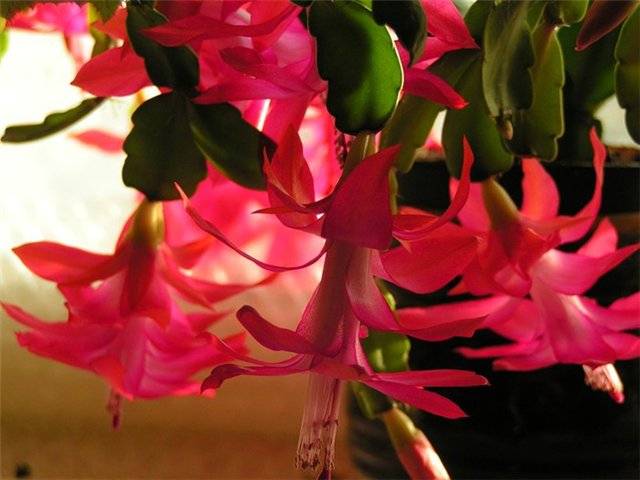

I want to remind you that to stimulate the growth of the Decembrist, it should be periodically turned, but during flowering, the flower is strictly forbidden to touch, move from place to place, you can not move at all - it can throw off all the buds and very abruptly.
5. The flower sheds buds — mites are usually to blame. If a spider mite has hurt, then on the fallen leaves there should be a yellow base with rusty-brown spots. Look carefully. If there is no tick or signs of it, shake the Decembrist slightly from side to side, perhaps he has problems with the roots.
The root system is the weakest part of the Decembrist, it easily rots, dies off at the slightest flaws during care. If the plant staggers, then it must be urgently transplanted into new soil and into a clean, disinfected old pot or into a new one.
All bad, acidic soil and affected roots are removed. Rinse the roots well under a stream of warm water (40-50 degrees) to surely put them in order.
The misconception that the Decembrist loses leaves and flowers from a lack of moisture. Therefore, by mistake, they begin to increase watering. The flower will begin to wilt rather than discard segments.
Answers on questions
Why does it drop the buds and the stem segments fall off?
- Dropping several buds may be the norm if the Decembrist has a large number of buds and the plant cannot supply all the buds. If Schlumberger's buds appeared in the spring, then they may fall off.
- The most common reason for dropping buds is an attack by a red spider mite. If you see that the Decembrist is dropping the buds and segments of the stem, then consider the plant. If the base of the stem turns yellow and is covered with small orangeish spots, then this is definitely a mite. You will be able to see the insects using a magnifying glass.
- If you have not found insects, then see how firmly the Christmas tree holds in the soil. If the zygocactus is swinging, this means that its roots have begun to die off and it urgently needs to be transplanted. In the Decembrist, the roots very often begin to rot:
- due to high or low temperature,
abundant watering or drought,
- due to a burn with top dressing, an attack of insects,
- changes in soil acidity.
If you see that the root system has begun to rot, then clear it of soil and rotten roots. Next, rinse with water at a temperature of 40-55 degrees, dry and place in a pot with new soil. Water the Decembrist sparingly at first, but spray often. Maintain high humidity. Better cover the plant with a plastic bag.
- The plant also sheds its buds due to the stress it experiences when conditions change. For example, if a Decembrist, who has been in the shade for a long time, is put in the sun.
- Also, this phenomenon can occur due to a lack of nutrients in the earth.
- Due to diseases. The roots start to rot due to fungi of the genus Fusarium, this is called Fusarium. You can get rid of the disease by applying the fungicides "Mikol" and "Bayleton". The root collar begins to rot due to the disease - phytium. In this case, use "Maxim" and "Vitaroz". If you find a brownish spot at the base of the stem, then this is late blight, which begins due to the bacteria Erwinia. Further, the spot spreads over the entire stem, sometimes the stem becomes discolored. This disease cannot be cured with fungicides, it is better to remove the diseased part of the plant.
- The buds fall off due to the low air temperature at a temperature of 10 degrees.
- With a lack of watering, the delicate tiny buds also begin to fall off.
Important! You cannot move the flowering zygocactus or twirl it around its axis, otherwise the flowers and even the buds will fall off.
Why did you pick up the buds, but does not bloom?
This means that the plant does not have enough moisture or fertilizers.
If this happens, then it is better not to rearrange the Decembrist and not turn it.Feed the plant with a weak mullein infusion. And it is better to start sprinkling it abundantly.
Why does it bloom in December?
The plant blooms in natural conditions in the midst of our winter, since in nature in the tropics, summer comes just in December and January. And accordingly, it blooms in the apartment at the same time.
What is the reason if the Schlumberger does not form buds well?
The juicy greenery of the Decembrist looks impressive. But, of course, the main feature of the plant is flowering. If this process is not the same as usual: the plant has stopped blooming or there are few buds, they are small, they quickly disappear, then such phenomena indicate the presence of problems with the health of the flower.
Problems with the root system of an indoor flower
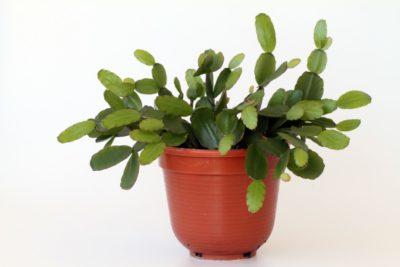

In zygocactus, the root system is weak, therefore, at the slightest defect in care, it is at risk.
This often happens due to excess liquid in the pot or moistening with cold water. Symptoms:
- falling of segments;
- acidification of the soil;
- soggy flowers;
- the appearance of black spots on the buds.
In case of root disease, it is urgent to inspect them, remove rotten areas and transplant them into new soil.
Be sure to treat the plant with systemic fungicides. Otherwise, such a serious problem threatens the loss of a pet.
Nutritional deficiency
During the year, the Decembrist is fed, the exception is the dormant period. Do it with mineral fertilizers. If the plant has not been transplanted for a long time, then the soil is accordingly depleted. He lacks nutrients for full development and flowering. Appearance also speaks of nutritional deficiency:
- pale green color;
- lack of growth;
- deformation of young shoots;
- dropping of buds and drying of ovaries.
In this case, the soil should be fed with fertilizers with nitrogen, potassium, phosphorus.
Why does the Christmas tree sometimes not grow for a long time or grows poorly, poorly? This may be due to:
- wrong transplant;
- unsuitable or poor composition of the substrate;
- fungal diseases;
- pest attacks;
- bad light;
- inappropriate irrigation system.
The main thing is to diagnose the cause in time and take action. Then the flower will grow again.
Transfer
A Decembrist transplant is carried out every year (in the case of young plants). Sometimes you have to resort to it more often if the cactus is growing rapidly. For a complete renewal of the substrate, old Christmas trees must be transplanted every 3-4 years.
It is better to change the pot between mid-summer and early autumn. Before transplanting, the cactus is pruned. Up to 50% of the shoots are removed. The pot is chosen wide, shallow, no more than 10% larger than the previous one.
Important: the material of the container for the Christmas tree does not matter, but it affects the ability of the soil to retain moisture. In ceramics, it evaporates faster, and in plastic, with frequent watering, there is a risk of decay.
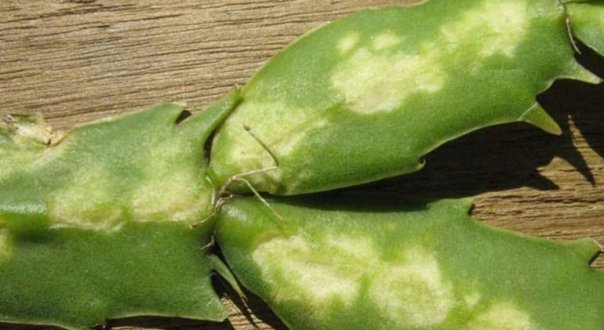

Necessary conditions for growing
A bright indoor flower like the Christmas cactus needs proper care in order to have the strength and potential to bloom profusely twice throughout the year.
Location and lighting
The best option for placing Schlumberger is an east-facing window sill. South windows for growing Decembrist are not suitable, since there is a high probability of yellowing and shedding of the segments under the influence of direct sunlight. In conditions of diffused light, the plant feels comfortable, grows and develops normally. If this is not possible, then at the hour of strong activity of the sun, the bush should be darkened.
Another important point: at the stage of bud formation and opening of flowers, you should not make any manipulations with the plant, in particular, change the location of the pot, unfold it. If you ignore this nuance, then the Decembrist will drop all the buds. In the summer, "walks" in the fresh air will be useful for him, a balcony, a loggia, a garden are suitable for these purposes.It is recommended to identify a vessel with a flower in a sufficiently illuminated area, while there should be no wind and direct contact with the scorching rays of the sun. When the zygocactus has faded, it is placed in a cool room until spring.
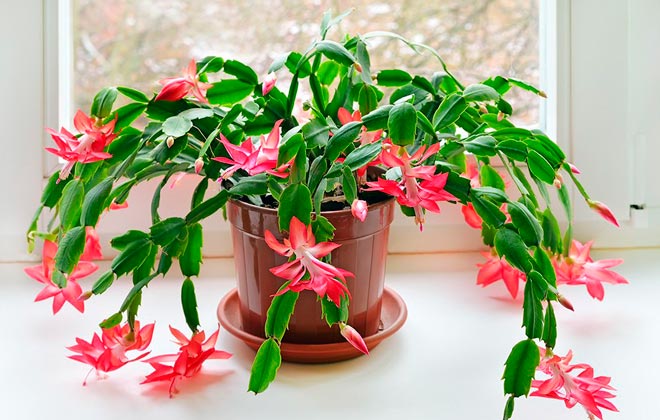

Air humidity
Zygocactus prefers to grow in high humidity conditions. In the hot season, it is advisable to spray it 2-3 times a day, but in winter such activities are reduced to 2 times a month. For a Schlumberger flower, high air humidity is only beneficial, but it is not recommended to place a vessel with a plant in a saucer of water - there is a high probability of the development of putrefactive processes of the root system. To be sure to determine the optimal level of humidity in the room, it is necessary to examine the Decembrist for the formation of air roots between the segments. If they do not dry out for two weeks, then the microclimate in the room is favorable for active vegetation.
Requirements for soil and pot
Typically, an exotic plant needs replanting every 3-4 years. The width of the pot for the Decembrist during the next transshipment should differ by 2 cm from the previous dimensions. The soil should be composed of peat, nutrient soil and sand mixed in a 2: 1: 1 ratio. The main condition is that the earth in the container should have a loose structure and a sufficient amount of useful components.
It is possible to improve the air and moisture permeability of the soil substrate by adding crushed charcoal, coarse sand or vermiculite to it.
Diseases
Diseases of the Decembrist can be fungal and bacterial in nature. They are manifested by the appearance of spots of different sizes, colors on the surface of leaves and buds. Treatment depends on the type of illness.
Why do the leaves of rhododendron turn yellow and what to do
The plant is bothered by such fungal diseases as late blight, phytium and fusarium. The first two come in with infected soil and damage the root system first. Fall of segments, wilting of buds and gray (pale) color of the plant are sure signs of fungal infection. The Decembrist is withering, what to do? You can help the flower by treating it with the following drugs: scor, topaz, maxim, vitaros.
The fungus of the latter penetrates not only with the soil, but also through the wounds of the zygocactus, which leads to decay of the roots and neck of the plant.
Important! A plant infected with fusarium cannot be saved, it can only be prevented. For the prevention of the disease, fungicides Mikal and Bayleton are used.


Segment affected by the fungal disease Fusarium
The bacterial infection is caused by Erwinia bacteria. A moist dark spot forms at the base of the stem, which subsequently covers the entire plant. The flower gradually takes on a red-purple hue. The defeat by bacteria is one of the most common reasons why the leaves of the Decembrist turned red. Treating infected areas is useless. They should be removed or a healthy cutting should be removed and a new plant grown from it.
Decembrist, lethargic leaves, why do the roots rot?
If infections in the flowerpot are not found, then why does the Decembrist and leaves fade? Sometimes the roots of a given plant rot for other reasons. This can happen in conditions of waterlogged soil and low temperatures. In cold weather, the Decembrist consumes less water, so it is important not to pour it over. When there is a lot of moisture, the soil begins to sour. If the room is also cold, then the likelihood of root rot is very high. In this case, the roots can no longer fulfill their role. Leaves and flowers receive practically no nutrition, so they begin to wither and fall off. The decay of the roots is indicated by the instability of the Decembrist. If it sways in the ground and it seems that it is easy to pull it out from there, then things are still in the roots.
If the room is warm, and the soil is with a normal level of moisture, why do the flowers of the Decembrist wither? Sometimes the roots disappear due to extreme overheating.If the flowerpot is in the sun, there is a high probability that the roots of the plant in it will begin to rot or burn. The first option is possible if there is a lot of moisture in the flowerpot. If the soil is dry, then the roots will simply dry out from the heat and the plant will die.
Not only sunshine is harmful to the Decembrist. It is difficult to survive the flower and the heat that comes from the batteries in the winter. Therefore, try to place it at the optimum distance from them.
Another reason for root death is a large amount of fertilizer. They literally burn the roots. Therefore, experienced flower growers warn against excessive feeding of the Decembrist. Everything should be moderate.
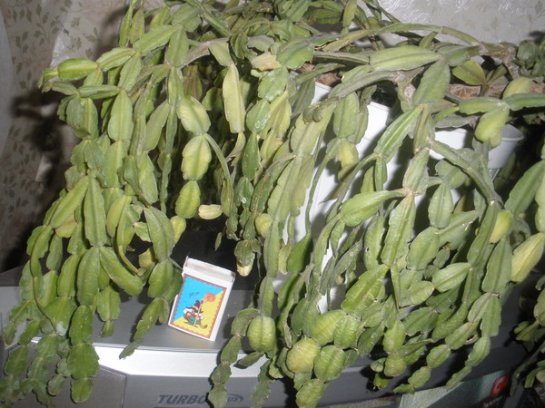

Air temperature
It is hard to believe that in nature there are moisture-loving cacti without thorns that cannot stand the sun. Well, another myth has been dispelled: the association of a cactus with a hot desert. The sun and a hot battery are dangerous for the Decembrist.


Unsuccessful place for a Decembrist - a window on the sunny side
Important! A sharp temperature drop can have a detrimental effect on the zygocactus. Protect the flower from drafts and do not leave it near an open window in winter.
Required temperature range:
| Temperature | Influence on the plant |
| Prevents the appearance of buds | |
| 10-15 ° C | Favorable temperature for flowering |
| 15-23 ° C | Comfortable temperature for growth |
| > 23 ° C | The establishment of peduncles is excluded. High temperature is the cause of lethargy and dryness of the leaves, and together with an excess of moisture, it contributes to decay of the roots. |
Correct care
The Decembrist on the windowsill is a spectacular plant that gives its bright inflorescences throughout the Christmas holidays. In order for the shoots to remain healthy, fleshy, it is necessary to organize the correct watering and feeding systems, systematically examine the flower for the presence of harmful organisms.
Lighting and temperature
The flower grows in its natural environment in the lower tier of the jungle - at home it needs a plentiful diffused color. In order for it to develop proportionally and bloom on more than one side, it is systematically rotated. The Decembrist is not picky about the temperature regime and can withstand a decrease in the mercury column to 0 ° C. The maximum critical temperature is 36 ° C.
Watering and feeding
Moisten the Decembrist moderately after the surface layer dries. Most of all, the flower needs moisture in the budding and flowering phases. The humidity level in the room is raised by placing a container of water next to the plant. The culture is fed only during the active growing season twice a month with the help of potassium-phosphorus fertilizers. Their concentration is halved.
Pest control
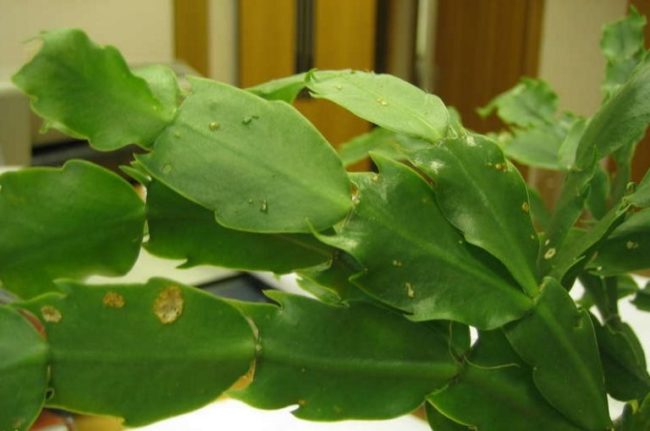

The Decembrist has a strong immunity. However, in case of excessive drought, spider mites colonize the shoots. The pest feeds on the juice of the stems. Good prevention is a systematic spraying of the crown, a warm shower (acceptable before the formation of buds). In case of strong colonization, the flower is sprayed with an insecticidal solution according to the instructions indicated on the package of the drug.
Decembrist is an abundant flowering plant. To avoid the problem of lethargy and softness of the shoots, it is enough to follow simple care measures.
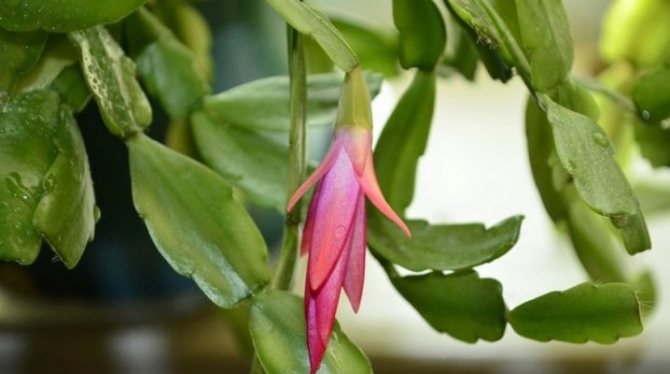

A native of the tropical rainforests of Brazil, zygocactus, popularly known as the Decembrist or Christmas cactus, has long and firmly won the hearts of indoor floriculture lovers. Beautiful multi-tiered flowers adorn the plant for two to three winter months. With simple, proper care Schlumberger blooms every year. But sometimes the Decembrist withers, stops blooming and, in the end, dies.


Reasons and measures of assistance if the bush turns red
Improper care
Red leaves appear for a number of reasons:
- Lots of bright lighting. This often happens in the spring and summer, when the plant is just moving away from winter. Therefore, it is better not to place the plant in very sunny areas of the premises.
- Incorrectly selected fertilizers.It is important to ensure that there is sufficient phosphorus in the nutrient complex.
- Red leaves are the first sign of over-watering. Regulate this process.
Plant features
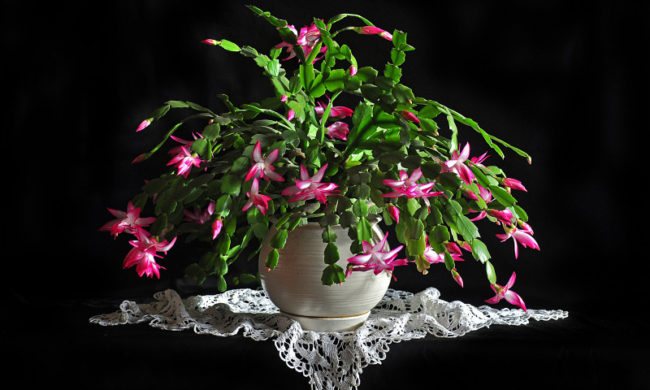

Decembrist is a plant with an epiphytic type of development. It attaches to the branches of shrub and tree species. On the windowsill, it feels great in the substrate, having a weak root system. Novice growers, looking at the articular thickening of the stem, take them for leaves. Thanks to the "isthmuses" between the fleshy segments of the shoots, the bush has a spreading appearance - the flower is used as an ampelous plant.
During the flowering period, which falls on the second half of December, funnel-shaped inflorescences of a star-shaped form bloom at the ends of the branches. The petals are arranged in several tiers. The color is often pink, but sometimes the buds are painted white. The Decembrist blooms profusely, which attracts many gardeners who decide to cultivate it in a pot.
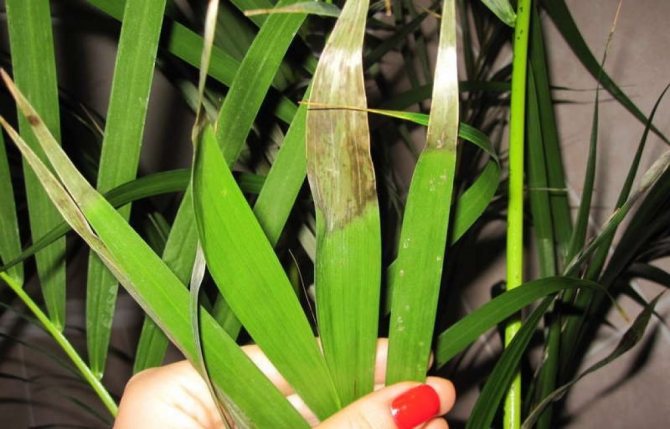

Useful video
From the video you will find out why the leaves of the Decembrist become sluggish:
We recommend that you familiarize yourself with our other materials about the epiphytic cactus - the Decembrist:
- When and how does it bloom at home?
- Types of a flower.
- How is it different from Ripsalidopsis?
Foliage dries - why and how to be?
Diseases and pests


The only pest that causes the leaves to dry out is the scale insect. Despite its diminutive size, this parasite can do a lot of harm to the Decembrist. The scabbard sucks out all the juices from the green part of the plant, which leads to their drying out. If you do not pay attention to the problem in time, the pest can completely destroy the flower. An excellent condition for the development of scale insects is considered to be high air humidity.
At the same time, very high air temperatures will help fight this parasite.
Reference. To get rid of the scabbard, you need to wipe all the green areas with a rag or cotton pad, first dipping them into Karbofos or Tanrek solutions.
Content errors
Typically, leaves begin to dry for one reason: the scorching rays of the sun. Florists, in pursuit of the goal of giving more light to the Decembrist, put it on the southern windowsills of the room. This should not be done in the summer. If there is no other option, except for the southern windowsill, then you should at least shade the flower from strong ultraviolet radiation. To do this, you can hang paper or reflective foil on the window.
Decay of roots
In addition to infections, there are other causes of the Decembrist's illness.
- flooding the soil. In winter, the Decembrist needs less water. Its flooding is fraught with soil acidification. At low temperature conditions, the process occurs several times faster. Not receiving nutrition from the root system, the flower withers. Leaves fall;
- fertilizer abuse. Top dressing should be moderate, its excess literally burns the roots;
- overheat. With prolonged exposure to direct sunlight, the roots prey in the presence of moisture in the pot or burn out in the absence of moisture.
Note! The Decembrist does not like the change of his location. It is difficult for its stems to turn towards the light, so even rotating the pot in the fall during a dormant period can lead to root rot. With the appearance of peduncles, you should also not get carried away with rearrangement, since most of the buds will immediately fade and may fall off.


Decay of the roots of the Decembrist
Knowing the reason, it is worth changing the conditions for keeping the plant: follow the rules of watering, do not get carried away with fertilizing, rearrange the flower in the shade. In the summer, you can take the flower outside to ventilate. This will eliminate soil acidification. If these measures do not help, you should transplant the flower or put it on the processes by cuttings (there should be at least 3 segments on one cuttings).
Care in which zygocactus always bloom
- Bright, but not aimed light.Do not keep the zygocactus on the northern windowsill (it may be dark here), but do not put it on the southern one (but here, on the contrary, there will be constant exposure to sunlight, which may result in a burn for the plant).
- In winter, the room should not be hot. At a constant temperature above 25 degrees, even a blooming cactus can lose its flowers.
- Do not flood this plant. A cactus is a succulent, and if you overexpose it in dry soil, it will not die due to the moisture accumulated in the leaves. If you water it too often, moisture will also stagnate in the pot (dense soil, lack or small amount of drainage), the matter will end with the appearance of rot and the death of Schlumberger.
- Water procedures. Spraying with warm water (in summer, in the heat), warm shower from dust (also in summer).
So, there are flowers! How to make sure that they do not fall off in a couple of weeks?
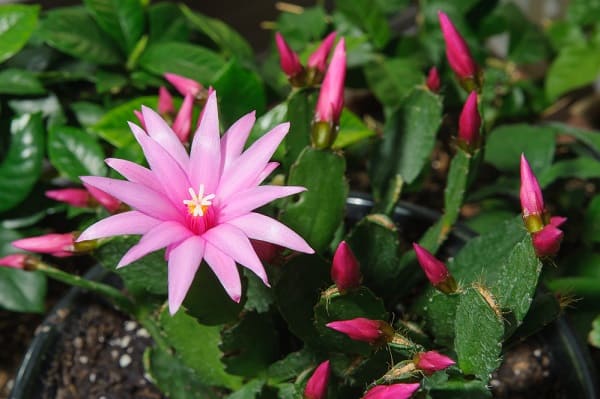

[collapse]
Decembrist wilted: what to do in case of infections?
So, you have determined why the Decembrist has sluggish leaves, what to do if there is an infection? If everything is not very neglected and the Decembrist has sluggish leaves just appeared, then it will be enough to treat the plant with special medicinal preparations. Popular of them are "Fitosporin", "Maxim", "Skor", "Topaz". Carry out the treatment throughout the plant, not forgetting about the root base.
Sometimes such measures are clearly not enough. For example, if the whole soil is affected by the infection. In this case, drugs will obviously not help. The only way out is to transplant the flower, and then treat it with medicine. Once in good fresh soil, the roots will begin to revive, they will begin to nourish the plant with water and nutrients. This will save the Decembrist.



